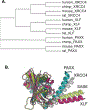XLF/Cernunnos: An important but puzzling participant in the nonhomologous end joining DNA repair pathway
- PMID: 28846869
- PMCID: PMC6685063
- DOI: 10.1016/j.dnarep.2017.08.003
XLF/Cernunnos: An important but puzzling participant in the nonhomologous end joining DNA repair pathway
Abstract
DNA double strand breaks (DSBs) are one of the most deleterious DNA lesions that promote cell death, genomic instability and carcinogenesis. The two major cellular mechanisms that repair DSBs are Nonhomologous End-Joining (NHEJ) and Homologous Recombination Repair (HRR). NHEJ is the predominant pathway, in which XLF (also called Cernunnos) is a key player. Patients with XLF mutation exhibit microcephaly, lymphopenia, and growth retardation, and are immunodeficient and radiosensitive. During NHEJ, XLF interacts with XRCC4-Ligase IV, stimulates its ligase activity, and forms DNA-binding filaments of alternating XLF and XRCC4 dimers that may serve to align broken DNA and promote ligation of noncomplementary ends. Despite its central role in NHEJ, the effects of XLF deficiency are surprisingly variable in different biological contexts, and different individual cell lines. This review summarizes the role of XLF in NHEJ, and the unexpected complexity of its interplay with other repair factors in supporting radiosurvival and V(D)J recombination.
Keywords: Nonhomologous End-Joining (NHEJ); V(D)J recombination; XLF/Cernunnos; XRCC4.
Copyright © 2017. Published by Elsevier B.V.
Figures





Similar articles
-
Interplay between Cernunnos-XLF and nonhomologous end-joining proteins at DNA ends in the cell.J Biol Chem. 2007 Nov 2;282(44):31937-43. doi: 10.1074/jbc.M704554200. Epub 2007 Aug 24. J Biol Chem. 2007. PMID: 17720816
-
Cernunnos/XLF: a new player in DNA double-strand break repair.Int J Biochem Cell Biol. 2009 Jun;41(6):1237-40. doi: 10.1016/j.biocel.2008.10.005. Epub 2008 Oct 17. Int J Biochem Cell Biol. 2009. PMID: 18992362 Review.
-
Deficiency of XLF and PAXX prevents DNA double-strand break repair by non-homologous end joining in lymphocytes.Cell Cycle. 2017 Feb;16(3):286-295. doi: 10.1080/15384101.2016.1253640. Epub 2016 Nov 10. Cell Cycle. 2017. PMID: 27830975 Free PMC article.
-
PAXX and XLF DNA repair factors are functionally redundant in joining DNA breaks in a G1-arrested progenitor B-cell line.Proc Natl Acad Sci U S A. 2016 Sep 20;113(38):10619-24. doi: 10.1073/pnas.1611882113. Epub 2016 Sep 6. Proc Natl Acad Sci U S A. 2016. PMID: 27601633 Free PMC article.
-
XRCC4 and XLF form long helical protein filaments suitable for DNA end protection and alignment to facilitate DNA double strand break repair.Biochem Cell Biol. 2013 Feb;91(1):31-41. doi: 10.1139/bcb-2012-0058. Epub 2013 Feb 5. Biochem Cell Biol. 2013. PMID: 23442139 Free PMC article. Review.
Cited by
-
Kaposi's sarcoma herpesvirus exploits the DNA damage response to circularize its genome.Nucleic Acids Res. 2024 Feb 28;52(4):1814-1829. doi: 10.1093/nar/gkad1224. Nucleic Acids Res. 2024. PMID: 38180827 Free PMC article.
-
Novel NHEJ1 pathogenic variant linked to severe combined immunodeficiency, microcephaly, and abnormal T and B cell receptor repertoires.Front Pediatr. 2022 Jul 27;10:883173. doi: 10.3389/fped.2022.883173. eCollection 2022. Front Pediatr. 2022. PMID: 35967585 Free PMC article.
-
Structure and mechanism in non-homologous end joining.DNA Repair (Amst). 2023 Oct;130:103547. doi: 10.1016/j.dnarep.2023.103547. Epub 2023 Jul 29. DNA Repair (Amst). 2023. PMID: 37556875 Free PMC article.
-
C-NHEJ without indels is robust and requires synergistic function of distinct XLF domains.Nat Commun. 2018 Jun 27;9(1):2484. doi: 10.1038/s41467-018-04867-5. Nat Commun. 2018. PMID: 29950655 Free PMC article.
-
PAXX binding to the NHEJ machinery explains functional redundancy with XLF.Sci Adv. 2023 Jun 2;9(22):eadg2834. doi: 10.1126/sciadv.adg2834. Epub 2023 May 31. Sci Adv. 2023. PMID: 37256950 Free PMC article.
References
-
- Povirk LF DNA damage and mutagenesis by radiomimetic DNA-cleaving agents: Bleomycin, neocarzinostatin and other enediynes, Mutat. Res 355 (1996) 71–89. - PubMed
-
- Hutchinson F Chemical changes induced in DNA by ionizing radiation, Prog. Nucleic Acid Res. Mol. Biol 32 (1985) 115–154. - PubMed
-
- Cadet J, Ravanat JL, TavernaPorro M, Menoni H, Angelov D Oxidatively generated complex DNA damage: Tandem and clustered lesions, Cancer Lett 327 (2012) 5–15. - PubMed
-
- Valerie K, Povirk LF Regulation and mechanisms of mammalian double-strand break repair, Oncogene 22 (2003) 5792–5812. - PubMed
-
- Walker JR, Corpina RA, Goldberg J Structure of the Ku heterodimer bound to DNA and its implications for double-strand break repair, Nature 412 (2001) 607–614. - PubMed
Publication types
MeSH terms
Substances
Grants and funding
LinkOut - more resources
Full Text Sources
Other Literature Sources

